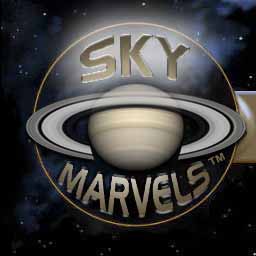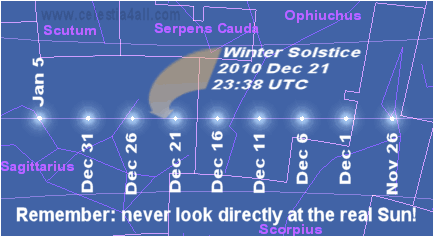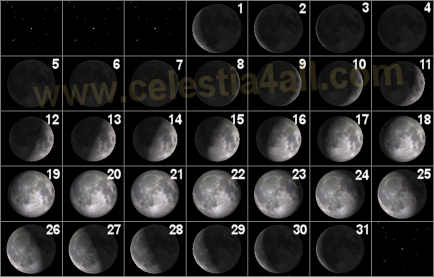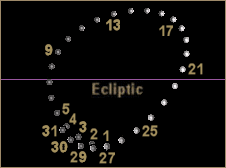








AVAILABLE MONTHS
2010:
Jan
Feb
Mar
Apr
May
Jun
Jul
Aug
Sep
Oct
Nov
Dec
2011:
Jan
Feb
Mar
Apr
May
Jun
![]() 1.6.x & 1.4.1 LINKS
1.6.x & 1.4.1 LINKS
Throughout this website you will find pairs of links labeled "1.6.x" and "1.4.1". Click here for a brief explanation.
UTC: CELESTIA'S DISPLAY OF TIME
CELESTIA's clock displays Coordinated Universal Time, UTC. Click here for a brief explanation.
WINTER BEGINS DECEMBER 21
Winter officially commences on December 21, as the Sun arrives at its most southerly point in the sky for the year. This is the "Winter Solstice", when daylight hours are at their shortest in the Northern Hemisphere and longest in the Southern.
A quick reminder: Winter is the shortest season, lasting only 89 days. This compares to: Spring: 92 3/4 days; Summer: 93 2/3 days and Autumn: 89 5/6 days. There is more information about the seasons on our News page for 2010 March.
APPARENT PATHS OF THE PLANETS
This month Mercury nears Mars again, while Saturn still lingers in central Virgo.
Note: in the 1.6.x and 1.4.1 links in this column below, planets east ("left") of the Sun are visible in your sky after sunset, while planets west ("right") of the Sun are visible before sunrise.

MERCURY: 2010 Dec
In the 2nd week of the month, Mercury goes retrograde and loops past Mars and then the Sun on its way back into the constellation Ophiuchus. (1.6.x) (1.4.1)
VENUS: 2010 Dec
Near mid-month, Venus exits Virgo and continues moving eastward in Libra (1.6.x) (1.4.1)
MARS: 2010 Dec
Occulted by the Moon on the 6th, Mars is then roughly two Moon diameters from speedy Mercury on the cusp of the 13th-14th. But both events take place very near the Sun. (1.6.x) (1.4.1)
JUPITER, URANUS & NEPTUNE: 2010 Dec
Uranus stays in Pisces and Neptune in Capricornus, but Jupiter manges to cross into Pisces from Aquarius before the Winter Solstice (1.6.x) (1.4.1)
SATURN: 2010 Dec
Saturn moves slowly to the east in central Virgo for the whole month (1.6.x) (1.4.1)
CELES-TIPS
The following will help you enjoy this page's many links that run events directly in CELESTIA. If you're new to the program, these tips will also help you learn to use it.
- If CELESTIA's clock (i.e. the program's date and time) is not visible at the top right of its window, press the V key until you see it. This will also turn on information text in other corners as well. This text will help you keep track of several aspects of the event you're viewing.
- Pressing the "un-shifted" L key and K key respectively will speed up and slow down CELESTIA's flow of time by a factor of 10 in version 1.6.x and 1.4.1.
- Pressing Shift+L and Shift+K respectively will speed up and slow down CELESTIA's flow of time by a factor of 2 in version 1.6.x only.
- Pressing the J key (either shifted or "un-shifted") will reverse CELESTIA's flow of time in version 1.6.x and 1.4.1.
You'll find more information about many of CELESTIA's controls on our Learning Center page.
HIGHLIGHT EVENTS
GEMINID METEOR SHOWER 2010
To view this video in a larger size, click here.
THE GEMINIDS: (at a glance)
Perhaps the best and most reliable of meteor showers!
When:
Entire Shower: December 7 through 17
Peak Activity: December 14, 11:00 Universal Time
Best Viewing: Very early morning, after moonset
How Long: (peak activity)
A day or more
How Many Meteors You May See: (at peak, clear sky)
Theoretically: 120 per hour
Realistically: 30-60 per hour
What Properties:
Color: Can vary from meteor to meteor
Speed: Medium to slow
Radiant at Peak: A little west of Castor
LUNAR ECLIPSE 2010 December 21
To view this video in a larger size, click here.
THE SUN
APPARENT PATH OF THE SUN: 2010 Dec
Here are the Sun's positions along the Ecliptic at 00:00 UTC on the days shown.

The slightly curved lines above and below the Ecliptic show the extent of the Zodiac, which you may download from our Bonuses page and add to any version of CELESTIA. Note that the curve in the Zodiac lines is the result of CELESTIA's rendering in perspective.
 W A R N I N G ! It is never safe to look directly at the real Sun with the naked eye! Moreover, looking at it through a telescope or binoculars—even for an instant—can cause permanent blindness! NEVER DO IT! Consult the professionals at your local planetarium or observatory to learn how you can safely "observe" the Sun and any SOLAR eclipse!
W A R N I N G ! It is never safe to look directly at the real Sun with the naked eye! Moreover, looking at it through a telescope or binoculars—even for an instant—can cause permanent blindness! NEVER DO IT! Consult the professionals at your local planetarium or observatory to learn how you can safely "observe" the Sun and any SOLAR eclipse!
Of course, you can safely view CELESTIA's depiction of the Sun's apparent path in the sky in December. Here are the links: (1.6.x) (1.4.1). Note that versions 1.6.x and 1.4.1 differ in the way their "follow" and "lock" features work. If you "follow" Earth and then "lock" the Sun to it, versions 1.6.x and 1.4.1 respectively maintain the "attitudes" of the Ecliptic and the the Celestial Equator. This means that the Ecliptic remains "level" when you run the first link, but begins to tilt when you run the second! Differences like this will be discussed on our Help page.
HALF OF EARTH IN SUNLIGHT & DARKNESS
During your voyages in CELESTIA, would you like to be able to position yourself directly over the center of the half of Earth in sunlight or the half in darkness at any time this month? On our Tips page, you'll find that it's quite easy to do so! If you're any kind of sky watcher at all, you probably know just how helpful this can be!
THE MOON
PHASES OF THE MOON: 2010 Dec
In UTC per CELESTIA 1.6.x:
New: Dec 5, 17:36. 1st Qtr: Dec 13, 13:59.
Full: Dec 21, 8:14. Last Qtr: Dec 28, 4:19.
(Celestia 1.4.1 usually indicates respective phase times within about one minute of those in version 1.6.x.)
NOTE: New, 1st Quarter, Full and Last Quarter Moons respectively are defined to occur when the Geocentric Ecliptic Longitudes of the Moon and the Sun differ by 0°, 90°, 180° and 270°.
To watch a short video demonstrating the Phases of the Moon, click here.

The above diagram is produced with our "Moon Phases Calendar" script. The numbers of the days of the month were added with an image-editing program.
To watch a short video of our Moon Phases Calendar in action, click here.
LUNAR APOGEE & PERIGEE: 2010 Dec
Per CELESTIA 1.6.x:
Apogee: Dec 13, 8:35 UTC; 404,419 km.
Perigee: Dec 25,12:04 UTC; 368,454 km.
(Celestia 1.4.1 usually indicates apogee and perigee times within about one minute of those in version 1.6.x. Both versions of Celestia almost always indicate equal apogee distances and equal perigee distances.)
Determined by our "Earth-Moon Distance" and "Moon's Apparent Path" scripts. Note that distances given are those between Earth's and the Moon's centers.
LUNAR ANALEMMA: 2010 Dec
Here is the lunar analemma, generated by the Moon's positions relative to the mean lunar orbit and the Ecliptic at 0:00 UTC every day of December. On the 1st and the 27th, the Moon is essentially in the same position relative to its mean orbit.

This phenomenon can be observed using our "Moon's Apparent Path" script. The analemma's change of shape month after month begins to give us an idea of just how irregular the lunar orbit is.
Back to Top
Home Intro News Gallery Sky-Gifts Bonuses Tips
Learning Ctr Help Links Credits Legal Contact Us
© 2007-
by Gary M. Winter. All rights reserved.
Interested in political cartoons and humor?
Check out The HIPPLOMATS™.
SkyMarvels, SkyMarvels: Your Key to the Sky and the Universe! Sky Marvels, SkyMarvels.com, celestia4all, celestiaforall, CELESTIA, astronomy, space, simulations, animations, downloadable astronomy posters, stars, planets, Inner Planets, Outer Planets, Inferior Planets, Superior Planets, moons, asteroids, comets, Oort Cloud, galaxy, galaxies, Milky Way, Andromeda, globular clusters, binaries, quasars, black holes, supermassive black holes, telescope, telescopes, planetarium, software, freestuff, satellites, add-ons, addons, scripts, eclipses, Solar Eclipses, Lunar Eclipses, Solar Eclipse Finder, Lunar Eclipse Finder, mutual eclipses, transits, occultations, Solar System, CELES-TOOLS, celeSTARrium, CELX, CELX programming, Freebies, Bonuses, multiple views, atronomical unit, light year, parsec, meteors, meteor showers, Perseids, Geminids, Leonids, barycenter, time, Time Zones, tides, alignments, conjunctions, oppositions, seasons, apogees, perigees, aphelion, perihelion, Earth, Luna, Mercury, Venus, Mars, Jupiter, Galilean Moons, Io, Europa, Ganymede, Callisto, Saturn, Titan, rings, Uranus, Neptune, Triton, E-MSpectrum, electromagnetic spectrum, astronaut, equinoxes, solstices, precession, rotation, spin, inclination, tilt, Ecliptic, orbits, ellipse, parabola, hyperbola
Donate safely with: PayPal
to receive one or more
Sky-Gifts. Your support is greatly appreciated!
Various astronomical "shadow events" occur throughout the Solar System! This month's more interesting ones are featured here.
SHADOW WORKS
Here we highlight the most awe-inspiring eclipses taking place in our Solar System. We also set them up so that all you need to do is click on their links. Don't forget that you can generate lists of Earth's, Jupiter's, Saturn's, Uranus's, Neptune's and even Pluto's eclipses, using CELESTIA's own built-in "Eclipse Finder." You'll find it in the program's menu under "Navigation".
All events listed below are displayed as if viewed from Earth, their magnifications shown in parentheses at the lower right of CELESTIA's window. Events involving more than one moon are often cyclical, so usually only the first example is given, and then the period of the cycle.
Remember: you can press the M key to toggle Moon Labels on and off .
 JUPITER
JUPITER
While no simultaneous solar eclipses occur on Jupiter in December, its major moons still put on a good show. On some occasions, 2 or more Galileans can be seen near Jupiter. Here are highlights of the 32 solar eclipses that Io, Europa, Ganymede and Callisto produce this month, while the shadow of Jupiter stretches to the east (left). Examples of some Galileans moving into it or emerging from it are included.
With this Galilean info, you can understand why some events involving more than one moon repeat. It also lets you predict when they may do so again.
Periods:
Io: 1.769 days
Europa: 3.551 days
Ganymede: 7.155 days
Callisto: 16.69 days
Resonances:
Io & Europa: 2 to 1
Io & Ganymede: 4 to 1
Europa & Ganymede: 2 to 1
- Dec 2: As Europa casts its shadow, Io and Ganymede are behind Jupiter not far away (1.6.x) (1.4.1)
- Dec 3: Europa follows Io behind Jupiter and into its shadow (1.6.x) (1.4.1)
- Dec 5: Io moves behind Jupiter; Ganymede and Europa move in front of it (1.6.x) (1.4.1)
- Dec 7: Similar to 3½ days ago, Europa follows Io behind Jupiter, but this time Callisto is also near Jupiter (1.6.x) (1.4.1)
- Dec 8: Callisto casts its shadow near Jupiter's south pole; you have to look closely to see this one (1.6.x) (1.4.1)
- Dec 16: Callisto, Europa and Io are near Jupiter; and here come Ganymede (1.6.x) (1.4.1)
 SATURN
SATURN
While CELESTIA 1.6.x shows the shadows of Titan, Rhea, Iapetus, Dione and Tethys, version 1.4.1 displays only the shadows of Titan, Rhea & Iapetus. So, 1.6.x and 1.4.1 respectively show 28 and no solar eclipses on Saturn in December. Version 1.6.x reveals only 1 simultaneous solar eclipse this month, and it's NOT an obvious one!
To aid in your viewing, here are the periods of Saturn's major moons. These do not exhibit the resonances that Jupiter's Galileans display. Still, you can use this info to predict subsequent eclipses of a single moon.
Tethys: 1.888 days
Dione: 2.737 days
Rhea: 4.518 days
Titan: 15.95 days
Iapetus: 79.33 days
- Dec 1: Tethys currently casts its shadow in Saturn (about every 2 days) (1.6.x only)
- Dec 2: Dione currently casts its shadow on Saturn (about every 2¾ days) (1.6.x only)
- Dec 29-30: Dione and Tethys cast their shadows on Saturn simultaneously (1.6.x only). This is another one you'll have to observe very closely to confirm (1.6.x only). You may even want to turn on Saturn's "terminator." Right Click on Saturn and then select Reference Vectors: Show Terminator.
URANUS, NEPTUNE & Dwarf Planet PLUTO
Neither Uranus nor Neptune will experience eclipses for decades. Dwarf planet Pluto will experience no eclipses by Charon for about a century!













